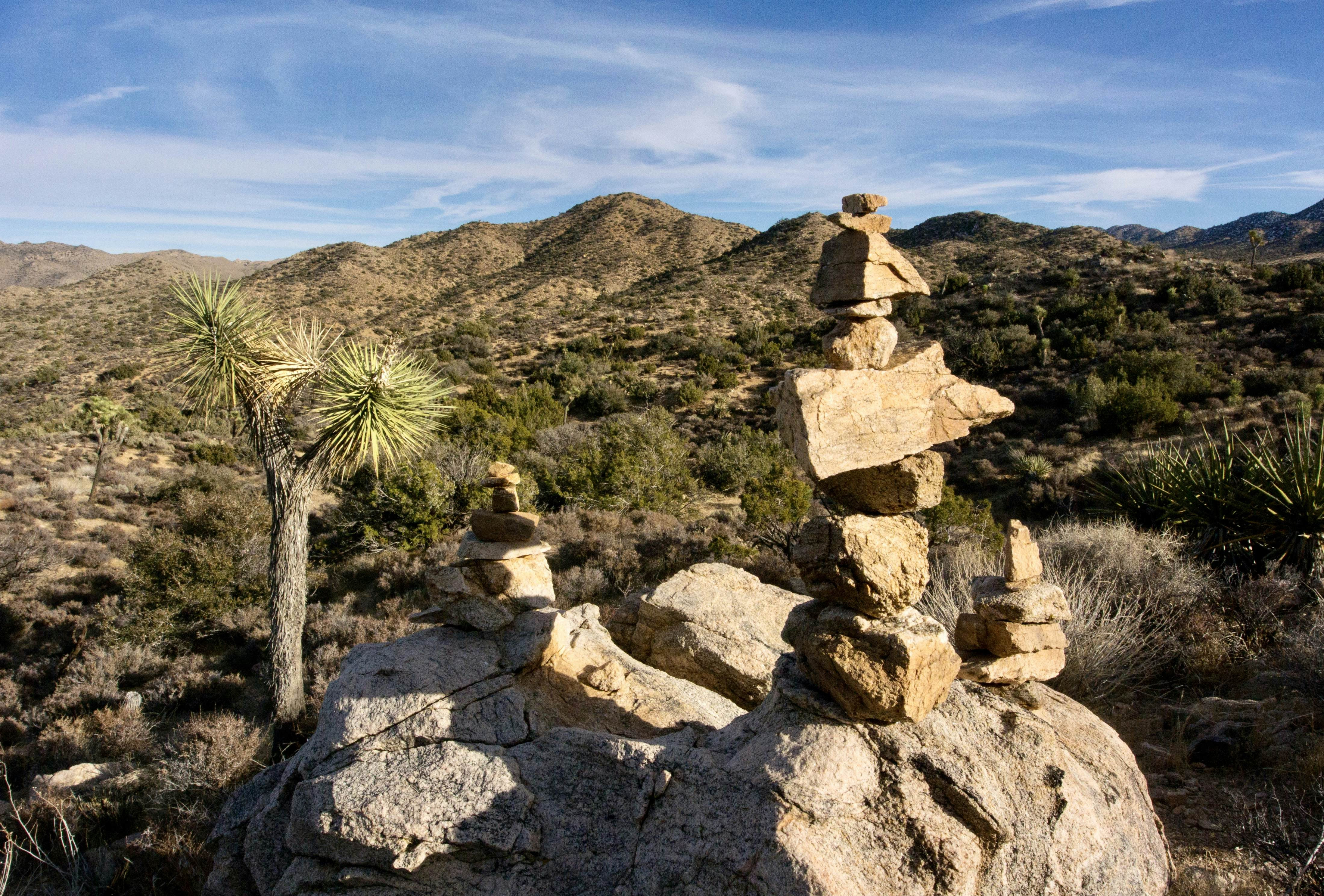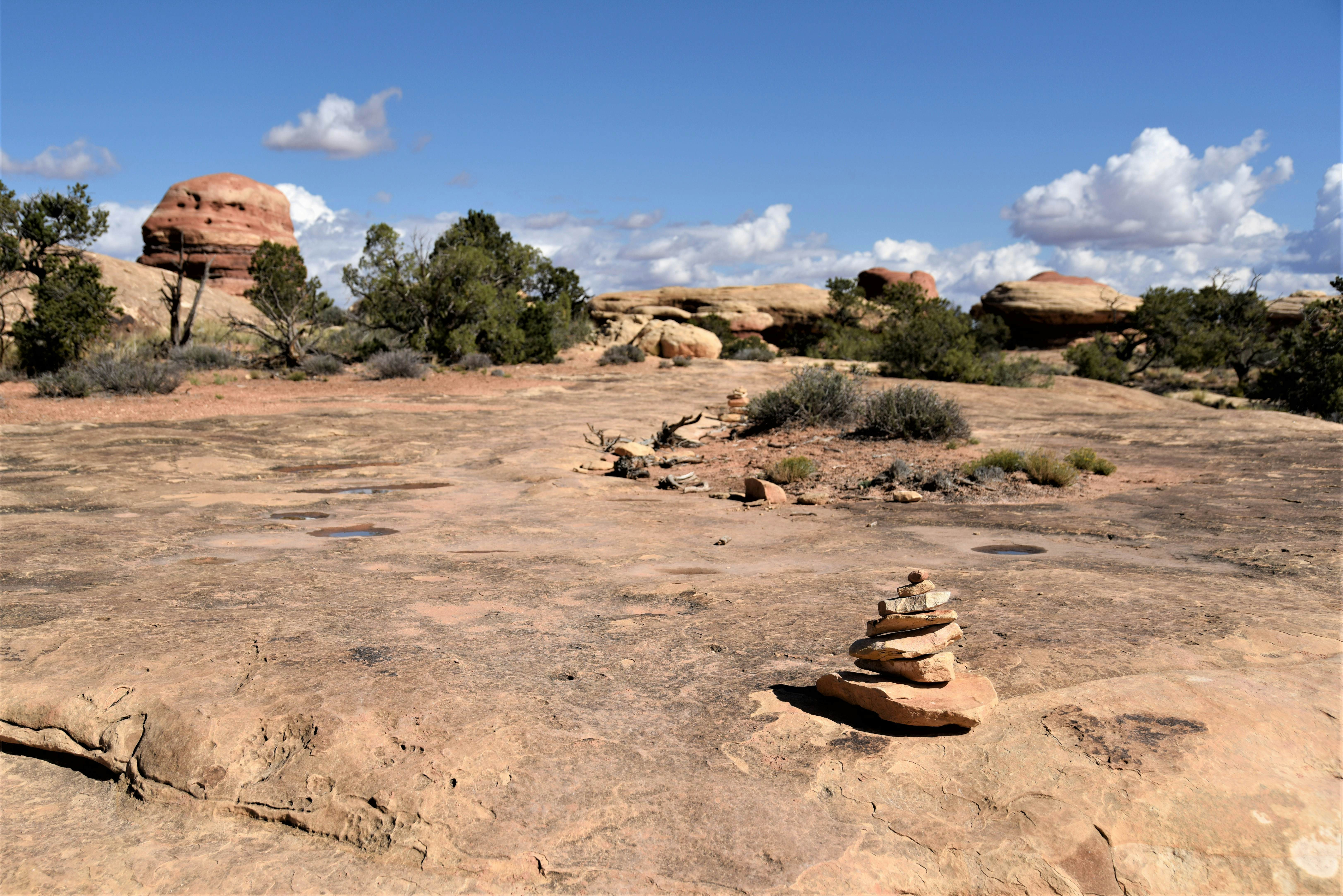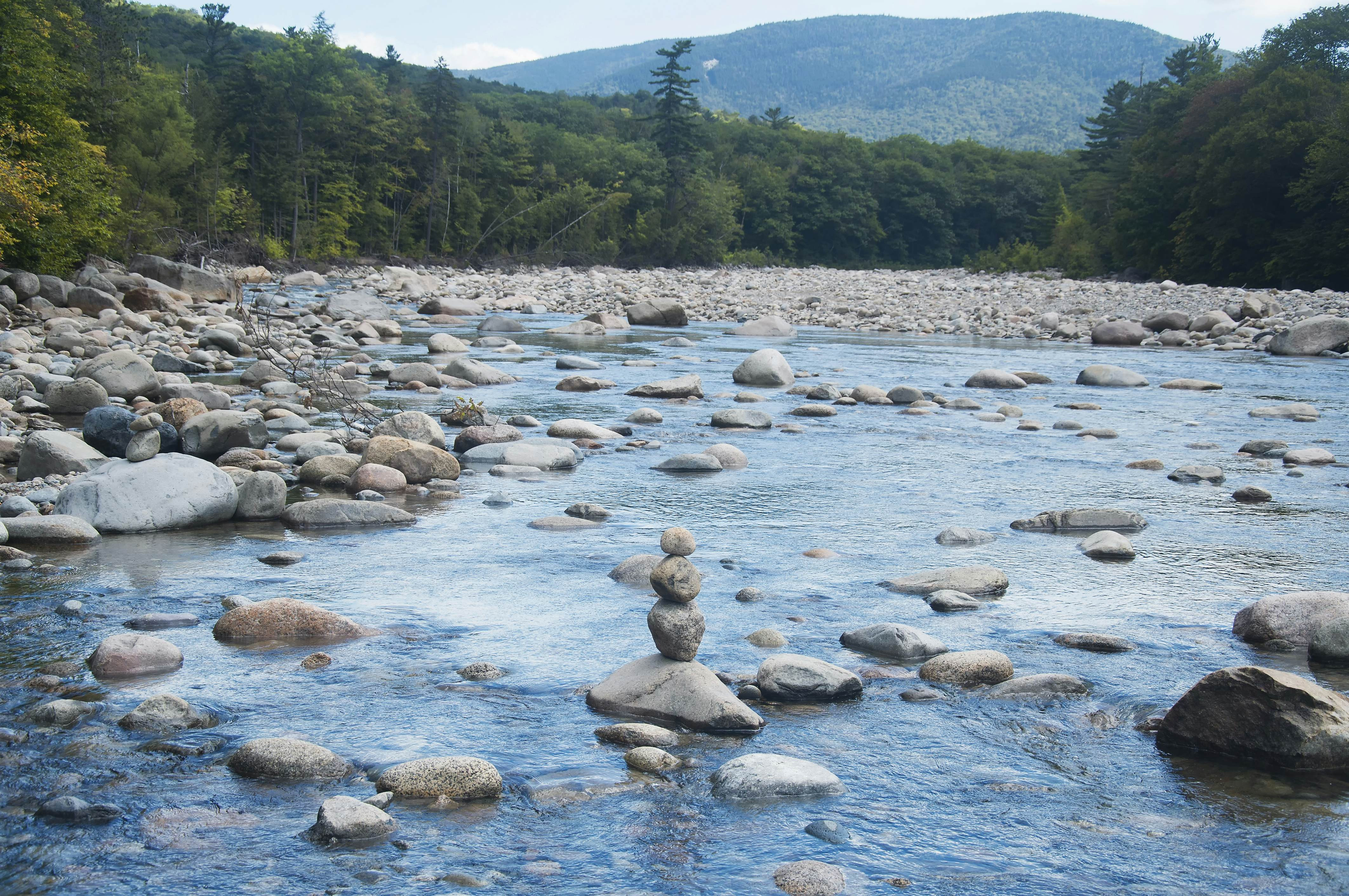Are you curious about the art of arranging stones in your outdoor space? At rockscapes.net, we’ll explore what a stack of rocks is called, diving into the world of cairns, rock balancing, and their significance in landscaping, offering you inspiration and ideas for your own rock arrangements. Discover the beauty and functionality of rock features in your yard with expert advice on rock arrangements, stone selection, and landscape design.
1. What Is A Stack Of Rocks Called?
A stack of rocks can be called several things depending on its purpose and construction. Generally, you might hear the terms cairn, rock pile, rock stack, or rock balance.
-
Expanding on the Terms
- Cairn: Traditionally, a cairn is a human-made stack of stones used as a landmark or memorial. Cairns have a long history across various cultures, serving as trail markers, burial monuments, or even for ceremonial purposes. The word “cairn” comes from the Scottish Gaelic word càrn, meaning a heap of stones.
- Rock Pile: This is a more general term that simply refers to a collection of rocks piled together, often without a specific artistic or functional intent. In landscaping, rock piles can be used for erosion control, creating habitats for wildlife, or as a decorative element.
- Rock Stack: Similar to a rock pile, a rock stack implies a deliberate arrangement of rocks, often for aesthetic appeal. Rock stacks can be simple or complex, involving balancing and arranging stones in visually pleasing ways.
- Rock Balance: This term specifically refers to the art of balancing rocks on top of each other, creating gravity-defying formations. Rock balancing is a form of ephemeral art, often practiced for its meditative and artistic qualities. Michael Grab, known as Gravity Glue, popularized this art form, creating stunning rock formations that seem to defy physics.
2. What Is the Purpose of Stacking Rocks in Landscaping?
Stacking rocks in landscaping serves multiple purposes, ranging from practical to aesthetic. These stone structures add texture, visual interest, and functionality to outdoor spaces.
-
Functional Purposes
- Erosion Control: Rock stacks can be strategically placed to prevent soil erosion on slopes or along waterways. The rocks help to slow down water flow and trap sediment, stabilizing the soil.
- Drainage: Rock piles can improve drainage by creating permeable areas that allow water to filter into the ground. This is particularly useful in areas with poor soil drainage.
- Habitat Creation: Rock stacks provide shelter and habitat for various wildlife, including insects, reptiles, and small mammals. These creatures contribute to the biodiversity of your garden.
- Boundary Markers: Similar to traditional cairns, rock stacks can define boundaries or mark pathways in your landscape.
-
Aesthetic Purposes
- Visual Interest: Rock stacks add a natural and rustic element to landscaping, creating a focal point or complementing existing features.
- Texture and Contrast: The varied shapes, sizes, and colors of rocks provide texture and contrast, enhancing the visual appeal of your garden.
- Artistic Expression: Rock stacking can be a form of artistic expression, allowing you to create unique and personalized landscape designs.
- Meditation and Mindfulness: The act of stacking rocks, especially in rock balancing, can be a meditative practice, promoting relaxation and mindfulness.
3. Where Did the Tradition of Stacking Rocks Originate?
The tradition of stacking rocks dates back centuries and spans across various cultures, each with its own unique purposes and meanings.
-
Historical and Cultural Significance
- Cairns as Landmarks: Ancient cultures used cairns as landmarks to mark trails, burial sites, and significant locations. These stone piles served as navigational aids and reminders of past events. In Mongolia, cairns marked burial sites, while in Tibet, Buddhists used them in ceremonies.
- Scottish Highlands: In the Scottish Highlands, cairns were erected on hilltops to commemorate important events or as landmarks for travelers. These cairns often grew over time as people added stones to the pile.
- Inuit Culture: The Inuit people of North America built inukshuks, similar to cairns, to serve as navigational aids in the vast Arctic landscape. These stone figures helped travelers find their way across the tundra.
- Indigenous Communities: Various Indigenous communities, from the Rocky Mountain foothills to the Dakota plains, used rock stacks as part of their hunting strategies, particularly for bison.
-
Modern Interpretations
- Trail Markers: Today, cairns are still used as trail markers in many hiking areas, helping hikers stay on course in remote or rugged terrain.
- Artistic Installations: Rock stacking has evolved into an art form, with artists creating intricate and gravity-defying structures using balanced stones. Michael Grab’s Gravity Glue is a prime example of this modern art form.
- Spiritual Practices: Some people practice rock stacking as a form of meditation or spiritual expression, finding peace and balance in the act of arranging stones.
4. What Types of Rocks Are Best for Stacking?
The best types of rocks for stacking depend on the desired aesthetic and the purpose of the rock stack. Different rock types offer varying textures, colors, and shapes, each contributing to the overall design.
-
Common Rock Types for Stacking
- River Rocks: Smooth and rounded river rocks are ideal for creating balanced stacks and natural-looking arrangements. Their varied sizes and colors add visual interest.
- Slate: Flat and layered slate rocks are easy to stack and create stable structures. Slate comes in various colors, from gray and black to green and purple.
- Limestone: Limestone rocks have a textured surface and irregular shapes, making them suitable for creating rustic and natural-looking rock stacks.
- Granite: Durable and weather-resistant granite rocks are excellent for building long-lasting rock stacks. Granite comes in various colors and patterns, adding visual appeal.
- Sandstone: Soft and porous sandstone rocks are easy to shape and stack, creating unique and textured arrangements.
- Fieldstones: These are rocks that have been naturally weathered over time and come in various shapes and sizes. They can add a rustic and natural look to landscaping.
-
Considerations for Rock Selection
- Size and Shape: Choose rocks with varying sizes and shapes to create dynamic and visually appealing stacks.
- Texture: Select rocks with interesting textures to add depth and dimension to your landscape design.
- Color: Mix and match rocks with different colors to create contrast and visual interest.
- Stability: Ensure the rocks are stable and secure when stacked to prevent accidents or collapses.
5. How Do You Build a Stable Rock Stack?
Building a stable rock stack requires patience, balance, and careful planning. Follow these steps to create a secure and visually appealing rock arrangement.
-
Step-by-Step Guide
- Choose a Location: Select a level surface for your rock stack. Ensure the ground is stable and free from loose debris.
- Gather Your Materials: Collect a variety of rocks in different sizes, shapes, and textures. Choose rocks that are easy to handle and stack.
- Start with a Base: Begin with a large, flat rock as the base of your stack. Ensure the base is stable and level.
- Find the Balance: Carefully place the next rock on top of the base, finding the center of balance. Adjust the position of the rock until it feels secure.
- Continue Stacking: Continue adding rocks one at a time, carefully finding the balance point for each rock. Use smaller rocks to fill in gaps and stabilize the stack.
- Adjust as Needed: As you build, step back and assess the stability and appearance of the stack. Make adjustments as needed to ensure the rocks are secure and visually appealing.
- Final Touches: Once you’ve reached the desired height, add any final touches, such as small stones or decorative elements.
- Consider the Environment: Be mindful of the environment. Avoid stacking rocks in sensitive areas or where it may disrupt wildlife habitats.
-
Tips for Stability
- Use a Level Base: A level base is essential for creating a stable rock stack.
- Find the Center of Balance: Carefully find the center of balance for each rock to prevent the stack from toppling over.
- Use Smaller Rocks as Wedges: Use smaller rocks to fill in gaps and stabilize the stack.
- Test the Stability: Gently test the stability of the stack as you build to identify any weak points.
6. What Are the Environmental Concerns Related to Rock Stacking?
While rock stacking can be a fun and artistic activity, it’s important to be aware of the potential environmental impacts. In protected areas like national parks, the practice can be particularly contentious.
-
Ecological Impact
- Habitat Disruption: Moving rocks from their natural location can disrupt the habitats of insects, reptiles, and other small creatures that rely on these rocks for shelter and food.
- Soil Erosion: Removing rocks from the ground can expose the soil to erosion, especially in sensitive areas like riverbanks and slopes.
- Vegetation Damage: Trampling on vegetation while searching for rocks can damage or destroy plant life, impacting the ecosystem.
- Cumulative Effects: Even seemingly small disruptions can have cumulative effects on the environment, especially in popular areas where many people stack rocks.
-
Aesthetic and Ethical Concerns
- Altering Natural Landscapes: Rock stacking can alter the natural appearance of landscapes, detracting from the wilderness experience for other visitors.
- Cultural Insensitivity: In some areas, rock stacks can be culturally insensitive, especially if they disturb or deface sacred sites or historical landmarks.
- Misleading Trail Markers: Unauthorized rock stacks can mislead hikers, causing them to lose their way or wander off established trails.
-
Responsible Rock Stacking
- Follow Local Regulations: Always check local regulations before stacking rocks, especially in national parks and other protected areas.
- Leave No Trace: Practice the “leave no trace” principle by returning rocks to their original location after you’re finished stacking.
- Avoid Sensitive Areas: Avoid stacking rocks in sensitive areas, such as riverbanks, wetlands, or areas with fragile vegetation.
- Minimize Impact: Minimize your impact on the environment by using rocks that are already loose and avoiding disturbing wildlife habitats.
7. How Does Rock Stacking Relate to the “Leave No Trace” Principle?
The “Leave No Trace” principle is a set of guidelines designed to minimize human impact on the environment. Rock stacking can sometimes conflict with these principles if not practiced responsibly.
-
The Seven Principles of Leave No Trace
- Plan Ahead and Prepare: Research the area you plan to visit and be aware of any regulations or restrictions.
- Travel and Camp on Durable Surfaces: Stick to established trails and campsites to avoid damaging vegetation and soil.
- Dispose of Waste Properly: Pack out everything you pack in, including trash, food scraps, and human waste.
- Leave What You Find: Avoid taking souvenirs or altering the natural environment, including stacking rocks.
- Minimize Campfire Impacts: Use campfires sparingly and only in designated fire rings.
- Respect Wildlife: Observe wildlife from a distance and avoid feeding or disturbing animals.
- Be Considerate of Other Visitors: Respect the peace and quiet of the outdoors and be mindful of other visitors.
-
Rock Stacking and Leave No Trace
- Leaving What You Find: Rock stacking can violate the principle of “leaving what you find” by altering the natural environment and potentially disturbing wildlife habitats.
- Minimizing Impact: To align rock stacking with the Leave No Trace principles, it’s important to minimize your impact on the environment by using rocks that are already loose and returning them to their original location after you’re finished.
- Following Regulations: Always follow local regulations regarding rock stacking, especially in protected areas where the practice may be prohibited.
8. Can Rock Stacking Be Considered Art?
Yes, rock stacking can certainly be considered an art form. The practice involves creativity, skill, and an appreciation for natural materials.
-
Elements of Rock Stacking Art
- Creativity: Rock stackers use their imagination to create unique and visually appealing arrangements of stones.
- Skill: Balancing rocks requires patience, precision, and a keen understanding of physics and balance.
- Aesthetic Appeal: Rock stacks can be beautiful and inspiring, adding a touch of natural art to outdoor spaces.
- Ephemeral Nature: Rock stacks are often temporary installations, adding to their artistic appeal and sense of impermanence.
-
Examples of Rock Stacking Art
- Gravity Glue: Michael Grab’s Gravity Glue is a prime example of rock stacking as an art form. His gravity-defying formations are both stunning and thought-provoking.
- Land Art: Rock stacking can be considered a form of land art, which involves creating art in and from the natural landscape.
- Sculptural Installations: Some artists create large-scale rock stacking installations that are designed to be permanent or semi-permanent features in outdoor spaces.
-
The Debate Over Art vs. Vandalism
- Intent and Impact: Whether rock stacking is considered art or vandalism often depends on the intent of the stacker and the impact on the environment.
- Respect for Nature: Responsible rock stackers respect the natural environment and avoid creating stacks that could harm wildlife or alter the landscape.
- Artistic Expression: When done responsibly, rock stacking can be a form of artistic expression that enhances the beauty of the outdoors.
9. What Are Some Creative Ideas for Incorporating Rock Stacks into Your Garden?
Incorporating rock stacks into your garden can add a unique and natural touch to your landscape design. Here are some creative ideas to inspire you:
- Rock Garden Focal Points: Create a rock garden as a focal point in your yard. Use a variety of rock types and sizes to create a visually interesting display. Add drought-tolerant plants to complement the rocks.
- Water Features: Integrate rock stacks into water features such as ponds or waterfalls. The rocks can add texture and visual interest to the water feature.
- Pathways and Borders: Use rock stacks to define pathways or create borders around garden beds. This can add a rustic and natural touch to your landscape design.
- Meditation Gardens: Create a meditation garden with rock stacks as a central element. The act of arranging stones can be a meditative practice.
- Wildlife Habitats: Build rock stacks to create habitats for wildlife, such as insects, reptiles, and small mammals.
- Vertical Gardens: Use rock stacks to create vertical gardens. The rocks can provide support for climbing plants and add visual interest to walls or fences.
- Sculptural Elements: Create sculptural rock stacks as standalone art pieces in your garden. Experiment with different shapes and sizes to create unique and eye-catching designs.
10. What Are Some Common Misconceptions About Rock Stacking?
There are several common misconceptions about rock stacking, often stemming from a lack of understanding of the practice and its potential impacts.
-
Misconception: Rock Stacking Is Always Harmless
- Reality: While rock stacking can be a fun and artistic activity, it’s not always harmless. Moving rocks from their natural location can disrupt wildlife habitats and contribute to soil erosion.
-
Misconception: Rock Stacks Are Always Trail Markers
- Reality: While cairns are sometimes used as trail markers, not all rock stacks are intended for this purpose. Unauthorized rock stacks can mislead hikers and cause them to lose their way.
-
Misconception: Rock Stacking Is a New Trend
- Reality: The tradition of stacking rocks dates back centuries and has been practiced by various cultures for different purposes.
-
Misconception: All Rock Stacking Is Vandalism
- Reality: When done responsibly and with respect for the environment, rock stacking can be a form of artistic expression rather than vandalism.
-
Misconception: Rock Stacking Is Easy
- Reality: Building a stable and visually appealing rock stack requires patience, skill, and a keen understanding of balance.
Are you ready to elevate your landscape with stunning rock features? Visit rockscapes.net today for inspiration, expert advice, and high-quality materials to bring your vision to life. Whether you’re looking to create a serene meditation garden, a functional retaining wall, or a striking rock sculpture, Rockscapes.net has everything you need to transform your outdoor space into a natural masterpiece. Let us help you create the outdoor oasis of your dreams with our wide selection of stones, innovative design ideas, and professional guidance.
Address: 1151 S Forest Ave, Tempe, AZ 85281, United States
Phone: +1 (480) 965-9011
Website: rockscapes.net
 Rock cairns created by visitors in Joshua Tree National Park, California, displaying the human impact on natural landscapes
Rock cairns created by visitors in Joshua Tree National Park, California, displaying the human impact on natural landscapes
 Cairns can be useful in marking hiking trails but that doesn't mean they are always a good idea, highlighting the importance of responsible trail marking
Cairns can be useful in marking hiking trails but that doesn't mean they are always a good idea, highlighting the importance of responsible trail marking
 Cairns mark the rugged trail in Canyonlands National Park, Utah, demonstrating the navigational role of cairns in wilderness areas
Cairns mark the rugged trail in Canyonlands National Park, Utah, demonstrating the navigational role of cairns in wilderness areas
 A hand setting a stone atop a cairn stone pile, illustrating the act of building a cairn and its potential environmental impact
A hand setting a stone atop a cairn stone pile, illustrating the act of building a cairn and its potential environmental impact
 A rock cairn in the middle of a river, representing the balance between human art and natural landscapes, and the need for environmental consideration
A rock cairn in the middle of a river, representing the balance between human art and natural landscapes, and the need for environmental consideration
FAQ About Rock Stacking
Q1: What is the difference between a cairn and a rock stack?
A1: A cairn is traditionally a stack of stones used as a landmark or memorial, while a rock stack is a more general term for an arrangement of rocks, often for aesthetic purposes.
Q2: Is it legal to stack rocks in national parks?
A2: In most national parks, it is prohibited to add your own cairns, as it can be considered vandalism and disrupt the natural environment. Always check with park rangers for specific regulations.
Q3: What are the environmental concerns related to rock stacking?
A3: Rock stacking can disrupt wildlife habitats, contribute to soil erosion, and alter the natural appearance of landscapes. It’s important to practice responsible rock stacking and follow Leave No Trace principles.
Q4: How can I build a stable rock stack?
A4: Start with a level base, find the center of balance for each rock, use smaller rocks as wedges, and test the stability as you build.
Q5: What types of rocks are best for stacking?
A5: River rocks, slate, limestone, granite, and sandstone are all good options for stacking, depending on the desired aesthetic and stability.
Q6: Can rock stacking be considered art?
A6: Yes, rock stacking can be considered an art form, involving creativity, skill, and an appreciation for natural materials.
Q7: What is the “Leave No Trace” principle, and how does it relate to rock stacking?
A7: The Leave No Trace principle is a set of guidelines to minimize human impact on the environment. Rock stacking should be practiced responsibly to align with these principles, such as leaving what you find and minimizing impact.
Q8: What are some creative ideas for incorporating rock stacks into my garden?
A8: Create rock garden focal points, integrate rock stacks into water features, use them as pathways or borders, build a meditation garden, or create wildlife habitats.
Q9: What are some common misconceptions about rock stacking?
A9: Common misconceptions include that it is always harmless, that all rock stacks are trail markers, and that it is a new trend.
Q10: Where can I find high-quality rocks for landscaping?
A10: Visit rockscapes.net for a wide selection of stones and expert advice on creating stunning rock features in your landscape.

